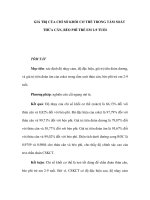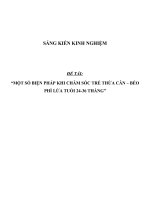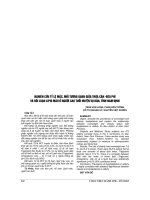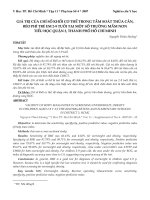So sánh tỷ lệ thừa cân béo phì đánh giá bằng chuẩn BMI theo tuổi của WHO và điểm cắt BMI theo IOTF
Bạn đang xem bản rút gọn của tài liệu. Xem và tải ngay bản đầy đủ của tài liệu tại đây (331.19 KB, 6 trang )
�����������������������������������������������������������������������������������������������������������������������������������������������������������������������������������������������������������������������������������������������������������������������������������������������������������������������������������������������������������������������������������������������������������������������������������������������������������������������������������������������������������������������������������������������������������������������������������������������������������������������������������������������������������������������������������������������������������������������������������������������������������������������������������������������������������������������������������������������������������������������������������������������������������������������������������������������������������������������������������������������������������������������������������������������������������������������������������������������������������������������������������������������������������������������������������������������������������������������������������������������������������������������������������������������������������������������������������������������������������������������������������������������������������������������������������������������������������������������������������������������������������������������������������������������������������������������������������������������������������������������������������������������������������������������������������������������������������������������������������������������������������������������������������������������������������������������������������������������������������������������������������������������������������������������������������������������������������������������������������������������������������������������������������������������������������������������������������������������������������������������������������������������������������������������������������������������������������������������������������������������������������������������������������������������������������������������������������������������������������������������������������������������������������������������������������������������������������������������������������������������������������������������������������������������������������������������������������������������������������������������������������������������������������������������������������������������������������������������������������������������������������������������������������������������������������������������������������������������������������������������������������������������������������������������������������������������������������������������������������������������������������������������������������������������������������������������������������������������������������������������������������������������������������������������������������������������������������������������������������������������������������������������������������������������������������������������������������������������������������������������������������������������������������������������������������������������������������������������������������������������������������������������������������������������������������������������������������������������������������������������������������������������������������������������������������������������������������������������������������������������������������������������������������������������������������������������������������������������������������������������������������������������������������������������������������������������������������������������������������������������������������������������������������������������������������������������������������������������������������������������������������������������������������������������������������������������������������������������������������������������������������������������������������������������������������������������������������������������������������������������������������������������������������������������������������������������������������������������������������������������������������������������������������������������������������������������������������������������������������������������������������������������������������������������������������������������������������������������������������������������������������������������������������������������������������������������������������������������������������������������������������������������������������������������������������������������������������������������������������������������������������������������������������������������������������������������������������������������������������������������������������������������������������������������������������������������������������������������������������������������������������������������������������������������������������������������������������������������������������������������������������������������������������������������������������������������������������������������������������������������������������������������������������������������������������������������������������������������������������������������������������������������������������������������������������������������������������������������������������������������������������������������������������������������������������������������������������������������������������������������������������������������������������������������������������������������������������������������������������������������������������������������������������������������������������������������������������������������������������������������������������������������������������������������������������������������������������������������������������������������������������������������������������������������������������������������������������������������������������������������������������������������������������������������������������������������������������������������������������������������������������������������������������������������������������������������������������������������������������������������������������������������������������������������������������������������������������������������������������������������������������������������������������������������������������������������������������������������������������������������������������������������������������������������������������������������������������������������������������������������������������������������������������������������������������������������������������������������������������������������������������������������������������������������������������������������������������������������������������������������������������������������������������������������������������������������������������������������������������������������������������������������������������������������������������������������������������������������������������������������������������������������������������������������������������������������������������������������������������������������������������������������������������������������������������������������������������������������������������������������������������������������������������������������������������������������������������������������������������������������������������������������������������������������������������������������������������������������������������������������������������������������������������������������������������������������������������������������������������������������������������������������������������������������������������������������������������������������������������������������������������������������������������������������������������������������������������������������������������������������������������������������������������������������������������������������������������������������������������������������������������������������������������������������������������������������������������������������������������������������������������������������������������������������������������������������������������������������������������������������������������������������������������������������������������������������������������������������������������������������������������������������������������������������������������������������������������������������������������������������������������������������������������������������������������������������������������������������������������������������������������������������������������������������������������������������������������������������������������������������������������������������������������������������������������������������������������������������������������������������������������������������������������������������������������������������������������������������������������������������������������������������������������������������������������������������������������������������������������������������������������������������������������������������������������������������������������������������������������������������������������������������������������������������������������������������������������������������������������������������������������������������������������������������������������������������������������������������������������������������������������������������������������������������������������������������������������������������������������������������������������������������������������������������������������������������������������������������������������������������������������������������������������������������������������������������������������������������������������������������������������������������������������������������������������������������������������������������������������������������������������������������������������������������������������������������������������������������������������������������������������������������������������������������������������������������������������������������������������������������������������������������������������������������������������������������������������������������������������������������������������������������������������������������������������������������������������������������������������������������������������������������������������������������������������������������������������������������������������������������������������������������������������������������������������������������������������������������������������������������������������������������������������������������������������������������������������������������������������������������������������������������������������������������������������������������������������������������������������������������������������������������������������������������������������������������������������������������������������������������������������������������������������������������������������������������������������������������������������������������������������������������������������������������������������������������������������������������������������������������������������������������������������������������������������������������������������������������������������������������������������������������������������������������������������������������������������������������������������������������������������������������������������������������������������������������������������������������������������������������������������������������������������������������������������������������������������������������������������������������������������������������������������������������������������������������������������������������������������������������������������������������������������������������������������������������������������������������������������������������������������������������������������������������������������������������������������������������������������������������������������������������������������������������������������������������������������������������������������������������������������������������������������������������������������������������������������������������������������������������������������������������������������������������������������������������������������������������������������������������������������������������������������������������������������������������������������������������������������������������������������������������������������������������������������������������������������������������������������������������������������������������������������������������������������������������������������������������������������������������������������������������������������������������������������������������������������������������������������������������������������������������������������������������������������������������������������������������������������������������������������������������������������������������������������������������������������������������������������������������������������������������������������������������������������������������������������������������������������������������������������������������������������������������������������������������������������������������������������������������������������������������������������������������������������������������������������������������������������������������������������������������������������������������������������������������������������������������������������������������������������������������������������������������������������������������������������������������������������������������������������������������������������������������������������������������������������������������������������������������������������������������������������������������������������������������������������������������������������������������������������������������������������������������������������������������������������������������������������������������������������������������������������������������������������������������������������������������������������������������������������������������������������������������������������������������������������������������������������������������������������������������������������������������������������������������������������������������������������������������������������������������������������������������������������������������������������������������������������������������������������������������������������������������������������������������������������������������������������������������������������������������������������������������������������������������������������������������������������������������������������������������������������������������������������������������������������������������������������������������������������������������������������������������������������������������������������������������������������������������������������������������������������������������������������������������������������������������������������������������������������������������������������������������������������������������������������������������������������������������������������������������������������������������������������������������������������������������������������������������������������������������������������������������������������������������������������������������������������������������������������������������������������������������������������������������������������������������������������������������������������������������������������������������������������������������������������������������������������������������������������������������������������������������������������������������������������������������������������������������������������������������������������������������������������������������������������������������������������������������������������������������������������������������������������������������������������������������������������������������������������������������������������������������������������������nh tính để hiểu thêm về khía cạnh văn hóa của
hiện tượng này ở trẻ vị thành niên TPHCM.
Tóm lại, như tác giả Shields va Tremblay
phát biểu “khi diễn giải tỷ lệ thừa cân và béo phì
ở trẻ em và trẻ vị thành niên, cần phải lưu ý đến
định nghĩa đã sử dụng và phương pháp thu
Nghiên cứu Y học
thập số liệu”(16). Việc sử dụng hai chuẩn đánh
giá quốc tế khác nhau để định nghĩa thừa cân và
béo phì ở trẻ em đưa đến sự khác biệt trong các
tỷ lệ thừa cân và béo phì. Ở thời điểm này, điểm
cắt của IOTF vẫn thích được sử dụng hơn vì dễ
so sánh với số liệu của nhiều nước. Tuy nhiên,
việc sử dụng điểm cắt BMI theo IOTF có thể ước
lượng thấp mức độ thừa cân và béo phì ở trẻ em.
Cần có thêm nghiên cứu để đánh giá nguy cơ
sức khỏe liên quan đến các điểm cắt BMI của trẻ
em theo IOTF và theo WHO.
TÀI LIỆU THAM KHẢO
1.
2.
3.
4.
5.
6.
7.
8.
9.
10.
11.
12.
13.
14.
Baya BA, Perez-Cueto FJ, Vasquez Monllor PA, Kolsteren PW.
(2010) International BMI-for-age references underestimate
thinness and overestimate overweight and obesity in Bolivian
adolescents. Nutr Hosp. (Comparative Study Research Support,
Non-U.S. Gov't). 25(3):428-36.
Choi J, Hwang J, Yi J. (2011) Acculturation, Body Perception, and
Weight Status Among Vietnamese American Students. Journal
of Immigrant and Minority Health:1-9.
Cole TJ, Bellizzi MC, Flegal KM, Dietz WH. (2000) Establishing a
standard definition for child overweight and obesity worldwide:
international survey. BMJ. 6;320(7244):1240-3.
Cole TJ, Green PJ. (1992) Smoothing reference centile curves: the
LMS method and penalized likelihood. Stat Med. 11(10):1305-19.
Cole TJ. (1990) The LMS method for constructing normalized
growth standards. Eur J Clin Nutr. 44(1):45-60.
de Onis M, Lobstein T. (2010) Defining obesity risk status in the
general childhood population: Which cut-offs should we use?
International Journal of Pediatric Obesity;5(6):458-60.
de Onis M, Onyango AW, Borghi E, Siyam A, Nishida C,
Siekmann J. (2007) Development of a WHO growth reference
for school-aged children and adolescents. Bull World Health
Organ. 85(9):660-7.
Dietz WH. (1998) Health consequences of obesity in youth:
childhood predictors of adult disease. Pediatrics. 101(3 Pt 2):51825.
Janssen I, Katzmarzyk PT, Boyce WF, Vereecken C, Mulvihill C,
Roberts C, et al. (2005) Comparison of overweight and obesity
prevalence in school-aged youth from 34 countries and their
relationships with physical activity and dietary patterns. Obesity
Reviews;6(2):123-32.
Kilpatrick M, Ohannessian C, Bartholomew JB. (1999)
Adolescent weight management and perceptions: an analysis of
the National Longitudinal Study of Adolescent Health. J Sch
Health. 69(4):148-52.
Kuczmarski RJ, Ogden CL, Grummer-Strawn LM, Flegal KM,
Guo SS, Wei R, et al. (2000) CDC growth charts: United States.
Adv Data. 8(314):1-27.
Lobstein T, Baur L, Uauy R. (2004) Obesity in children and
young people: a crisis in public health. Obes Rev. May;5 Suppl
1:4-85.
Lobstein T, Frelut ML. (2003) Prevalence of overweight among
children in Europe. Obes Rev;4(4):195-200.
McElhone S, Kearney JM, Giachetti I, Zunft HJ, Martinez JA.
(1999) Body image perception in relation to recent weight
Hội nghị Khoa Học Kỹ Thuật Trường Đại Học Y Phạm Ngọc Thạch 2012
159
Nghiên cứu Y học
15.
16.
17.
160
Y Học TP. Hồ Chí Minh * Tập 16 * Phụ bản của Số 1 * 2012
changes and strategies for weight loss in a nationally
representative sample in the European Union. Public Health
Nutr. 2(1A):143-51.
Pedrosa C, Correia F, Seabra D, Oliveira BM, Simoes-Pereira C,
Vaz-de-Almeida MD. (2009) Prevalence of overweight and
obesity among 7-9-year-old children in Aveiro, Portugal:
comparison between IOTF and CDC references. Public Health
Nutrition. (Comparative Study Research Support, Non-U.S.
Gov't). 14(1):14-9.
Shields M, Tremblay MS. (2010) Canadian childhood obesity
estimates based on WHO, IOTF and CDC cut-points.
International Journal of Pediatric Obesity.5(3):265-73.
Singh AS, Mulder C, Twisk JW, van Mechelen W, Chinapaw MJ.
(2008) Tracking of childhood overweight into adulthood: a
systematic review of the literature. Obes Rev. 9(5):474-88.
18.
19.
20.
21.
22.
Tăng Kim Hồng và cộng sự. (2010) Factors associated with
adolescent overweight/obesity in Ho Chi Minh city. Int J Pediatr
Obes. 5(5):396-403.
Tăng Kim Hồng và cộng sự. (2009) Factors associated with
physical inactivity in adolescents in Ho Chi Minh City, Vietnam.
Med Sci Sports Exerc. 41(7):1374-83.
Wang Y, Lobstein T. (2006) Worldwide trends in childhood
overweight and obesity doi:10.1080/17477160600586747.
International Journal of Pediatric Obesity;1(1):11-25.
Wang Y, Monteiro C, Popkin BM. (2002) Trends of obesity and
underweight in older children and adolescents in the United
States, Brazil, China, and Russia. Am J Clin Nutr. 2002 June
1;75(6):971-7.
Who Multicentre Growth Reference Study G, de Onis M. (2006)
WHO Child Growth Standards based on length/height, weight
and age. Acta Pædiatrica.;95:76-85.
Hội nghị Khoa Học Kỹ Thuật Trường Đại Học Y Phạm Ngọc Thạch 2012









